
Why should you curate a buyer persona story?
- Business Services
In today's dynamic marketing landscape, understanding your audience is not just an advantage - it's a necessity. Amidst the vast sea of audience data and competing brand messages, curating a resonant buyer persona story can make all the difference. But what is a buyer persona story, and why should you curate one? In this article, we'll explore these questions, delving into the importance and relevance of storytelling for your marketing strategy.
Recapping briefly from our previous article 'What is a Buyer Persona?', a buyer persona is a semi-fictional representation of your ideal customer based on market research and data about your existing customers. A buyer persona goes beyond traditional audience demographics, delving into the motivations, behaviors, and goals that drive your customers' decisions. But to be successful, a persona shouldn't just exist in isolation; instead, it should exist as part of a broader narrative, a story that helps you understand, connect with, and engage your audience meaningfully.
Table of Contents
- The definition and importance of curating a buyer persona story
- Understanding the power and importance of buyer persona stories
- Why is storytelling in marketing more compelling?
- Crafting a buyer persona story with audience segments
- The role of audience intelligence in story curation
- Gather audience data
- Analyze and segment your audience
- Identify the key characteristics, themes and trends of each segment
- Create your personas
- Craft narratives using real audience data
- Implement your buyer persona stories into your marketing strategy and measure their effectiveness
- Review and refine your stories
- Why should you curate a buyer persona story? The strategic advantage
- The role of audience intelligence in story curation
The definition and importance of curating a buyer persona story
A buyer persona story is more than a fact-filled profile or set of audience demographic data. Instead, it's a narrative that brings your buyer personas to life, supporting their journey from a prospect to a loyal customer. A well-crafted buyer persona story incorporates demographic data, behavior patterns, motivations, and goals to create a fully-fledged emblem of your customers, what they're looking for from a product or service, and how they interact with your brand.
But why should you invest time into curating a buyer persona story? A compelling buyer persona story serves multiple essential functions in your marketing strategy:
- It humanizes your audience, enabling your team to better empathize with and understand your customers. By curating buyer persona stories, it's easier to view your audience as people rather than a set of demographic data.
- It also provides crucial context, shedding light on the circumstances, challenges, and aspirations that shape your customers' purchasing decisions and buying habits.
- Beyond that, a well-structured buyer persona story can guide your marketing efforts, informing everything from product development to content creation, messaging, and marketing channel selection.
By taking the time to understand your customers' stories, it becomes easier to tailor your marketing strategies to engage them effectively and achieve your desired results.
So, let’s have a look at what this could look like.
In the previous article introducing this topic, titled, ‘What is a buyer persona?’, we looked at the audience segments most highly engaged with the topic of ‘sustainability’ online, acquired from audience research using Pulsar TRAC.
Here’s a quick reminder:
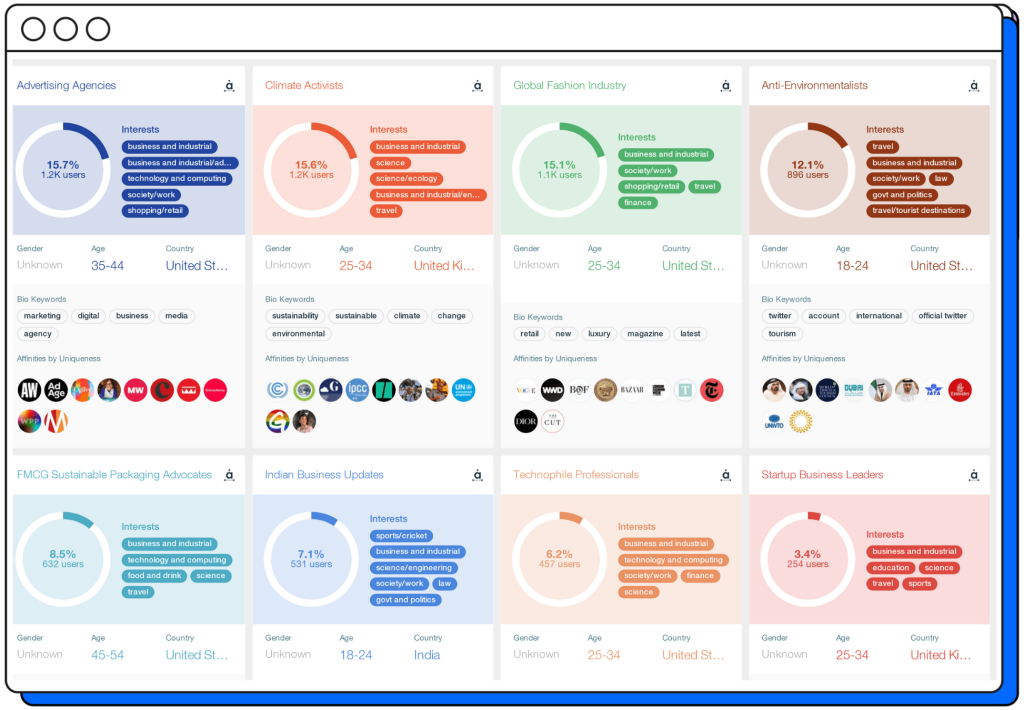
We can pinpoint the most active audience segments within online sustainability discussions utilizing the 'Communities' feature within Pulsar TRAC. Gaining insight into your prominent audience segments is just the beginning. With the backing of audience intelligence, this knowledge serves as your launch pad for developing precise, informed, and impactful buyer persona stories.
But before we move on to explore why you should curate a buyer persona story, it’s vital to understand their importance and power.
Understanding the power and importance of buyer persona stories
Buyer persona stories transcend traditional demographic and behavioral data. They bring to life the raw statistics and paint a vivid, holistic picture of your target audience. Understanding your audience's desires, frustrations, values, and life context is pivotal to crafting marketing strategies that truly resonate.
A well-constructed buyer persona story allows marketers to empathize with their audience, leading to more informed decisions on product development, messaging, and advertising choices, such as which social network will prove more effective. According to research from the MarTech Series, 86% of potential customers are more likely to make a purchase when provided with a personalized buying experience. While 36% of companies experience a shorter sales cycle when revolving their marketing strategy around buyer personas. By understanding your audiences, you'll become better equipped to deliver solutions that meet their needs, wants, and expectations, ultimately improving customer satisfaction and brand loyalty.
Why is storytelling in marketing more compelling?
Stories are integral to human communication and can often mean anything from books to poems, fiction, and even marketing. In a general sense, narratives, in any form, have been used throughout history to inform, entertain, and inspire. They capture attention and keep readers engaged by stimulating emotions influencing thoughts, feelings and perspectives.
In marketing, storytelling is a powerful tool because it can create connections between brands and audiences by engaging them, ultimately amplifying brand messages to become more memorable and impactful.
Stories help facts and figures become more digestible and relatable, ultimately helping consumers understand and remember the brand's value proposition. Through storytelling, you can create a compelling narrative that brings to life otherwise impersonal statistics.
For example, let’s return back to our research on sustainability audience segments:
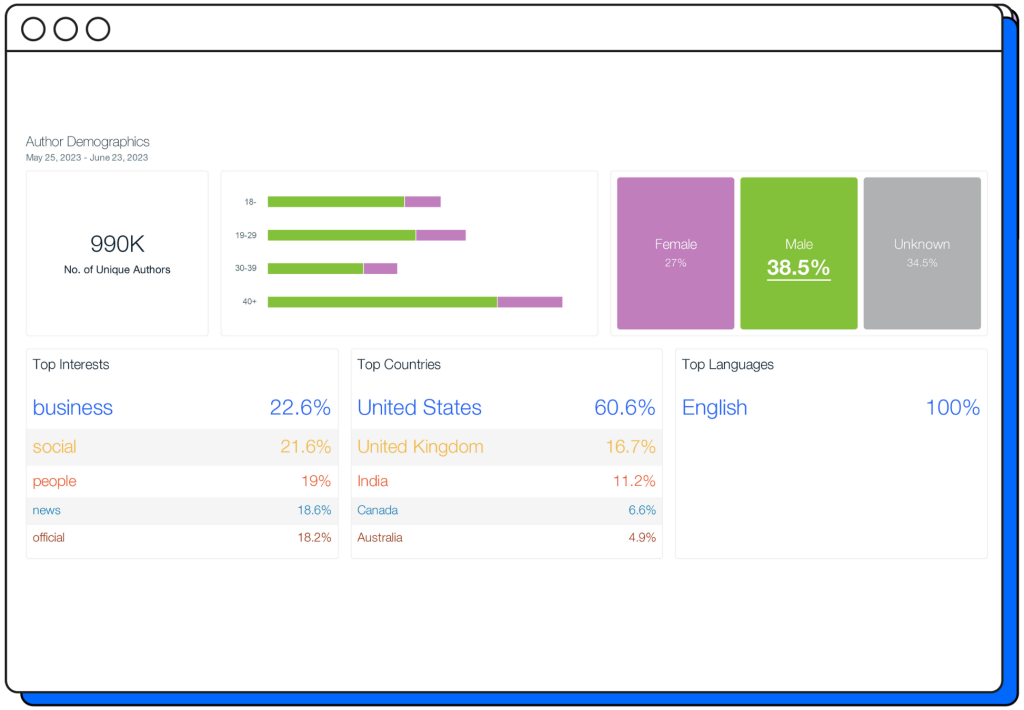
Relying solely on audience demographics to inform our understanding is a superficial approach that would render crafting accurate and effective buyer persona stories virtually impossible. Pulsar TRAC is a robust tool that delivers comprehensive insights that can enrich your traditional buyer personas, ranging from basic audience demographics to the intricate depth of audience intelligence. However, it would be a strategic misstep to halt your audience research at mere demographics. While the audience demographics acquired by Pulsar TRAC go beyond traditional demographic data due to their dynamacy, there's so much more to the story with the full capabilities of audience intelligence.
Demographic data might reveal that within the sustainability audience, the primary community is men over 40 based in the United States, but this is just the tip of the iceberg. Curating a buyer persona story necessitates diving deeper. Use this demographic information as a launching point to explore the underlying layers of your audience's identity. Discover who they are as individuals, their core beliefs, and what they need and want from a product or service.
Beyond this, stories can influence decision-making processes, making storytelling a persuasive tool in marketing strategies. A compelling tale is one that sparks interest. By leveraging storytelling, marketers can spark curiosity, foster trust, and ultimately motivate their audience towards their brand or business's desired outcomes.
The role of emotion in shaping buyer persona stories
Emotion is a driving force for action. When you align your brand's narrative with your audience segments' emotional needs, wants and desires, you have a higher chance of achieving the results you strategised, ultimately producing a successful marketing campaign through an ability to resonate with your audience.
Audience intelligence enables marketers to identify the emotions that affect different audience segments. By understanding your audience's values, interests, and concerns surrounding their purchasing decisions and buying habits, you can curate a buyer persona story that stirs the emotions that drive them to act. Whether it's a mother who values safety and reliability in a car or a millennial who wants their purchases to contribute to sustainability, effective storytelling appeals to these emotional triggers to foster deeper connections with your brand, encouraging loyalty.
The persuasive power of well-crafted stories
However, it doesn't just take targeting your audiences' sweet spots for a buyer persona story done right, as the narrative must flow well in each particular context.
A well-crafted story has the potential to alter opinions, influence decisions, and motivate actions. Curating a buyer persona story isn't just about presenting facts and figures but creating an experience the audience can personally connect with and relate to.
Crafting an engaging narrative is the essential first step when curating a buyer persona story. Your story should present a problem your audience can relate to, introduce your brand as the solution, and show the positive outcome of choosing your product or service. From this, you're not just selling a product or providing a service but offering a solution to their pain points.
By enriching buyer persona’s with audience intelligence, marketers can uncover their audience segments' motivations, challenges, and desires, using this data to create compelling stories that truly resonate with their audience for ultimate marketing success.
So, let’s delve deeper into the subject of audience intelligence and its power.
Crafting a buyer persona story with audience segments
In our preceding piece on 'What is a buyer persona?', we thoroughly examined the confines of traditional buyer personas. This exploration highlighted the superior approach of enriching and elevating buyer personas with audience segments driven by audience intelligence.
But how do we transform raw data and insightful audience segments into vibrant narratives that can fuel our marketing initiatives? By curating captivating buyer persona stories, we can bring our data to life, transforming our personas from static snapshots into dynamic narratives that reflect the multifaceted nature of our audience.
In this next stage, we'll delve into how audience segments can aid in sculpting an engaging narrative to bolster your marketing initiatives, outlining the process of crafting these narratives from the early stages of acquiring audience data to constructing your compelling narratives. This narrative will not only convey the nuances of your target audience but will also provide a solid framework for crafting personalized, impactful strategies.
The role of audience intelligence in story curation
So, now we’ve introduced the subject of audience intelligence in relation to buyer personas, let's explore how deeper audience insights can help us curate strong and compelling buyer persona stories. In this section, we'll delve into how audience intelligence is the key link between raw data and the curation of powerful narratives.
An easy way to understand this is by considering audience intelligence as the bridge between raw data and compelling buyer persona stories. It provides a deeper understanding of various audience segments, revealing their motivations, interests, behaviors, and attitudes. Such insights form the recipe for creating stories that truly resonate.
So, how does audience intelligence enable curating compelling buyer persona stories? Remember, utilizing audience segments to build your buyer persona stories is not to replace traditional methods, but to enhance them. When aided with the dynamacy of audience intelligence, you’re able to create more accurate and more compelling stories to uplift your marketing strategy. But as with everything, curating effective persona narratives involves a process if you’re going to do it right.
Let’s outline to steps to curating a buyer persona story supported by audience intelligence:
-
Gather audience data
The first step is to gather the audience data - this will act as the foundation or basis of your buyer personas. Before creating compelling narratives, it’s essential to spend time understanding your audience and building solid personas to bounce off. Using audience intelligence tools like Pulsar TRAC, you can acquire detailed audience data to offer valuable insights into your target audience or market. This data could include demographics, geographic location, top interests, occupation, spoken languages, and more. Establishing these insights provides the fundamental basis from which you can begin to weave together your compelling buyer persona stories.
-
Analyze and segment your audience
With the foundation of the audience data set, it's time to move to the next step: dissecting these insights and categorizing your audience based on shared affinities. This process involves scrutinizing the collected data to recognize distinctive clusters that demonstrate the multifaceted nature of your audience. During this stage, pay close attention to recurring themes within demographics, interests, traits, and behaviors. Such thorough analysis paves the way for crafting precise and knowledgeable audience segments that will later inspire and inform the narratives of your buyer personas.
-
Identify the key characteristics, themes and trends of each segment
Once you've invested time dissecting your audience and their respective segments, it becomes crucial to highlight their essential characteristics, prevalent themes, and trends to enhance the authenticity of your buyer persona stories. Dedicate efforts to comprehend their defining attributes, such as their motivations, concerns, preferences, purchasing behaviors, etc. These patterns serve as the primary narrative threads of your stories, aligning seamlessly with the interests and concerns of your audience, thereby enhancing their resonance.
-
Create your personas
This stage is where the storytelling comes in. Armed with the data and insights you've meticulously gathered, you can weave compelling narratives around each of your buyer personas. While buyer personas humanize your audience data, stories take this one step further by painting a vivid picture of your audience, what they want, how they behave, and what influences their decisions - capturing their desires, behaviors, and decision influencers in a tangible and relatable way. This process isn't just about cataloging demographics but a vital phase in bringing your audience segments to life.
Begin by giving your personas names – this seemingly simple step can do wonders in humanizing your data, making the personas feel more like real individuals you’re engaging with.
Next, assign them basic demographic attributes relevant to your product or service. You might consider:
- How old is your buyer persona?
- Where do they work?
- Where do they live?
We'll look at a mock audience persona named "Strategic Steve," a 40-year-old lead strategist living in the USA, just below.
Remember, these personas are not set in stone but are reference points you can revisit and refine as you gain more insights about your audience. As your understanding deepens, you can start adding layers to your personas. In the next section, we'll explore how to weave the rich tapestry of professional goals, personal interests, and lifestyle choices into the narratives that make your personas representative of your audience segments.
However, bear in mind that these narratives need to be grounded in the reality of your audience data. The objective here isn't to create an interesting fictional character but to bring forth the human elements within your data for more effective and empathetic marketing.
-
Craft narratives using real audience data
This stage is where the storytelling comes in. Armed with the data and insights you've meticulously gathered, you can weave compelling narratives around each of your buyer personas. While buyer personas humanize your audience data, stories take this one step further by painting a vivid picture of your audience, what they want, how they behave, and what influences their decisions - capturing their desires, behaviors, and decision influencers in a tangible and relatable way. Building a comprehensive narrative around each persona should delve into the intricacies of your segment, extending far beyond traditional demographic data or loose identifiers. Curating a buyer persona story should bring a particular audience segment to life - it's akin to painting a vibrant portrait or sculpting a detailed character for a novel. You're not merely presenting data; you're inviting readers to invest in and understand the journey of these personas.
When building your narrative just some of the questions you should ask yourself is:
- How do they spend their time?
- What are their professional goals?
- What are their personal goals?
- What are their core values or beliefs?
- What interests them?
- How do they interact online?
- What kind of content do they consume, and on what platforms?
- What is their decision-making process when making a purchase?
- Who influences their buying decisions (friends, celebrities, online reviews, etc.)?
- What is their relationship with your industry or topic of interest?
- What challenges or pain points do they face that your product or service can solve?
-
Implement your buyer persona stories into your marketing strategy and measure their effectiveness
Though you've completed your buyer personas stories at this stage, the process is far from over. It's crucial to continuously assess their efficacy over time and adjust your marketing strategies as needed. Ask yourself - are these stories enhancing your results? Do they provide a more profound understanding of your target audience? Curating buyer persona stories is not a one-time task but a dynamic process that thrives on feedback and adaptation to yield improved outcomes.
-
Review and refine your stories
A fundamental advantage of enhancing your buyer personas and their narratives with audience intelligence is their dynamism. Traditional buyer personas can quickly become outdated due to the ever-evolving nature of audiences, necessitating frequent updates. In contrast, buyer personas enriched with audience intelligence sidestep this problem. By harnessing tools like Pulsar TRAC, you can tap into real-time audience insights, ensuring your personas and their corresponding narratives remain timely and relevant. Naturally, once you complete the process of curating and drafting your narratives for the first time, reviews and refinements of these stories are essential to maintain their precision and potency in your marketing strategy.
So what does this look like in practice?
Let’s look at the most dominant audience segment within the sustainability audience as an example.
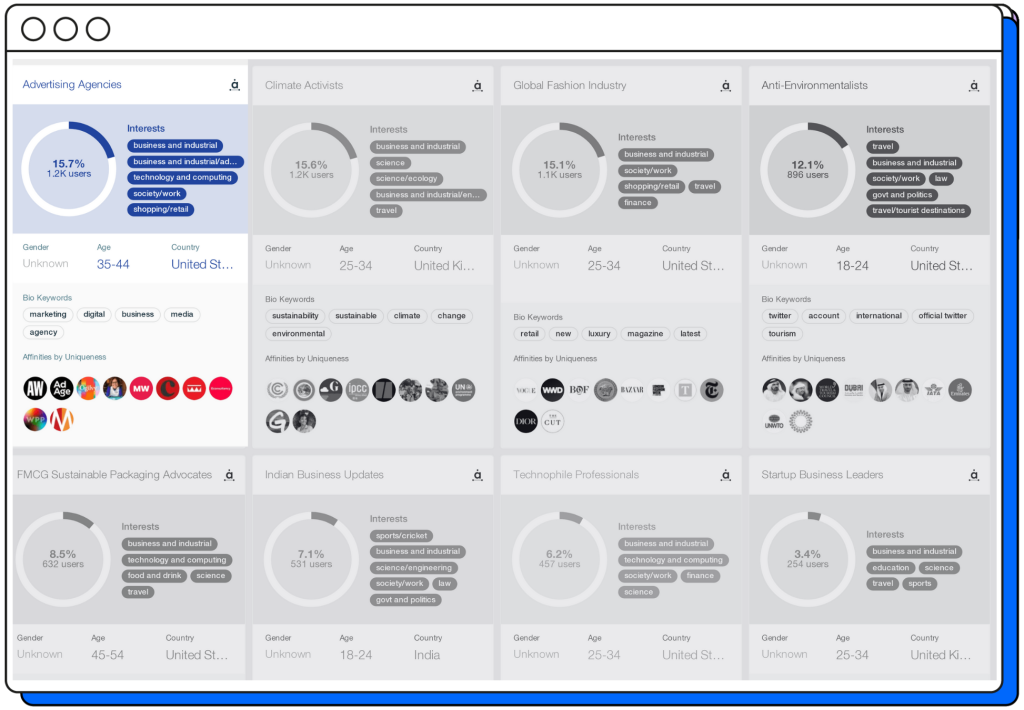
An example buyer persona story, based on information provided in the ‘Advertising Agencies’ audience segment, could look like this:
Strategic Steve
Steve is a 40-year-old Lead Strategist at a top advertising agency in the United States. Within his field, Steve is known for his expertise in digital marketing and media trends. While he has always heavily focussed on business and industrial growth, in recent months, Steve has grown an increasing interest in sustainability. In his eyes, sustainability presents an exciting new challenge and opportunity for evolution by distinguishing his advertising agency as a frontrunner in popular conversations dominating social media, attracting a new client base. On the other hand, Steve views the challenge as integrating sustainability messages into their existing business model, all while retaining the agency's core values and strengths for authenticity.
In line with this new business-related interest, Steve also translates this development into his personal life to better understand the concept, exploring and purchasing from eco-friendly retail options. As a result, he often finds himself browsing through retail websites that offer eco-friendly products and has even made a few planet-friendly product-swap purchases himself. Steve believes by growing his knowledge of the sustainability movement outside of work, he'll be able to use this newly acquired knowledge to influence others within his agency that eco-friendly messaging is a route worth exploring for positive change.
While Steve's journey towards living a sustainable lifestyle is very much in its early stages, he is eager to learn more about sustainability. Although a desire to make an impact and incite change within his workplace and industry is the factor that drives Steve, he is also reflecting this interest within his personal life by exploring more eco-friendly retailers and engaging with trending conversations on social media.
The depiction of 'Strategic Steve' animates our audience segment, sculpting a fictitious yet resonant persona grounded in real audience insights. This crafted persona becomes the foundation of your marketing initiatives, steering your strategy to success.
Based on our audience research, ‘Advertising Agencies’ are the biggest community with the largest share of voice online concerning the subject of sustainability.
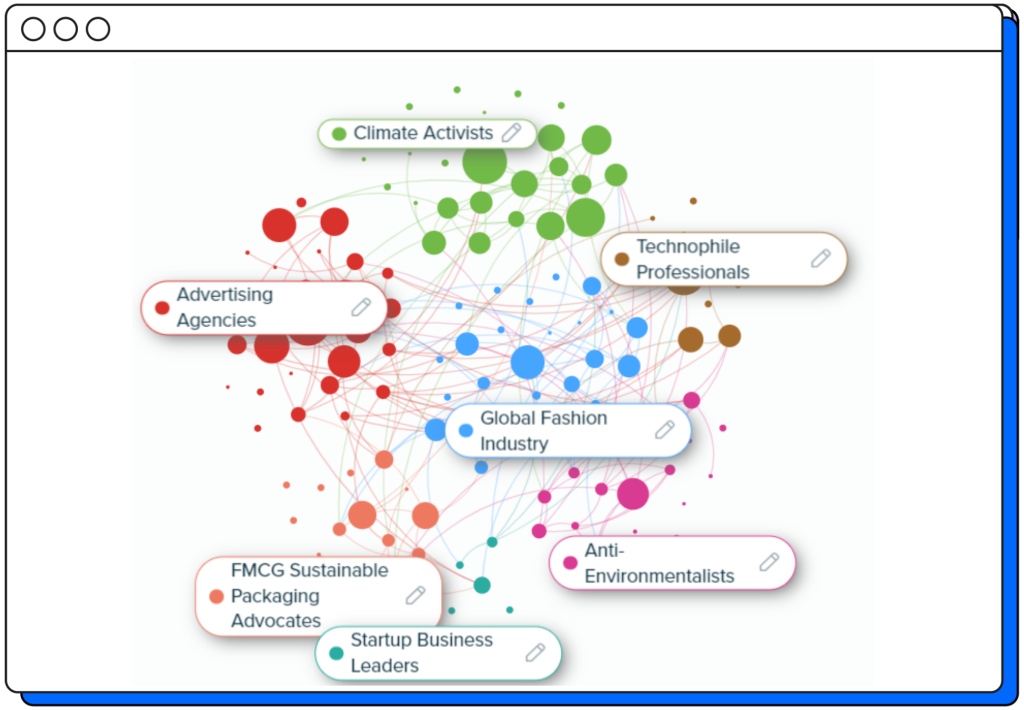
But let’s take a closer look at the second largest audience segment, ‘Climate Activists’, for another example of a buyer persona story.
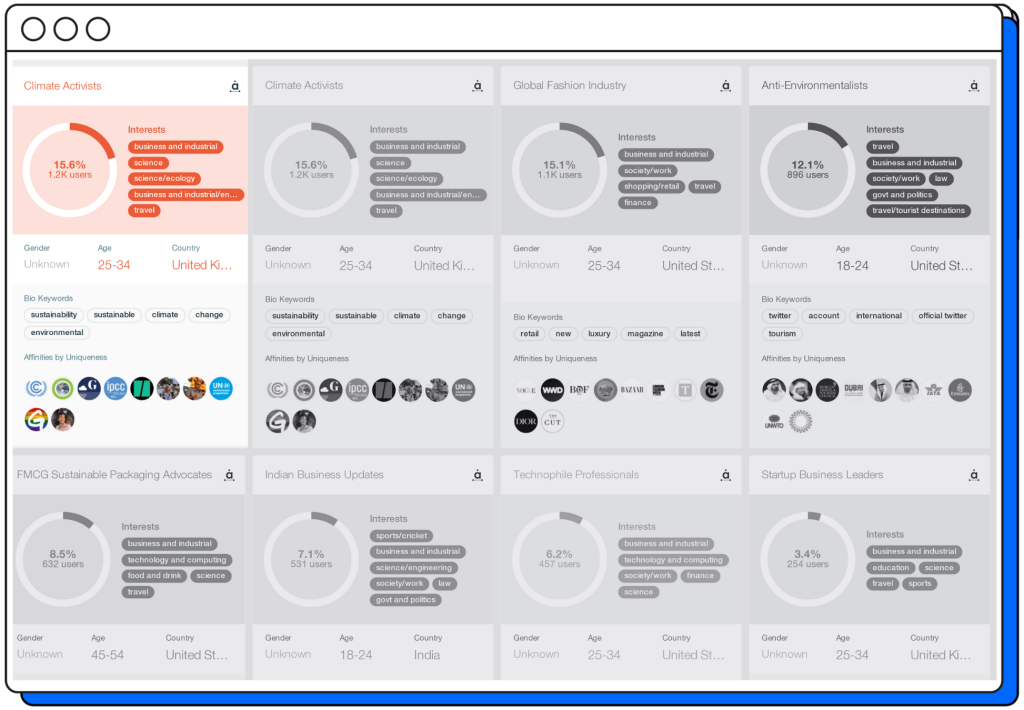
Science-Savvy Green Greg
Greg is a 33-year-old project manager, based in the United Kingdom, with a deep-seated interest in science. Fascinated by the complexities of the natural world and humanity's interactions with it, Greg often spends his free time diving into the latest scientific literature, specifically focused on environmental science.
His profession allows him to manage projects with a keen eye for efficiency and waste reduction. Yet, his passion extends beyond the workplace. Greg's love for travel has led him to experience the world's wonders and witness first-hand the impacts of climate change and environmental degradation.
These global adventures have only fueled Greg's dedication to sustainable practices. He actively participates in social media discussions on climate science and shares articles and insights about sustainable practices he discovers in his travels. Greg seeks to influence others by demonstrating the application of science in daily decision-making, particularly concerning purchases. He consciously supports brands prioritizing sustainability, viewing his consumer choices as opportunities to contribute to a greener world.
Guided by scientific understanding and a globetrotter's perspective, Greg aims to inspire others in his professional and personal networks to adopt sustainable practices. His goal is to turn his passion for science into a tangible impact on the environment, one project, one discussion, and one purchase at a time.
The role of audience intelligence when curating and enriching buyer persona stories is irrefutable. Demonstrated in the 'Strategic Steve' and 'Science-Savvy Green Greg', audience intelligence provides critical data about the audience, including their interests, behaviors, demographics, and more. This data forms the foundation of our buyer personas, allowing us to understand and humanize our audience on a deeper level.
However, personifying this data into narrative form truly brings these personas to life. This narrative approach goes beyond static data points to encompass a dynamic understanding of the audience - their desires, motivations, goals, and more.
Audience intelligence provides the real-time insights necessary to keep these stories relevant and accurate as your audience evolves. In essence, audience intelligence is fundamental in the curation of effective and dynamic buyer persona stories, enabling marketers to engage with their audiences on a far more personal and empathetic level. This dynamic approach ensures that your marketing efforts continually resonate with your target audience, encouraging unceasing engagement and brand loyalty.
Why should you curate a buyer persona story? The strategic advantage
In conclusion, curating a buyer persona story isn't merely a helpful tool but a necessary addition to modern-day digital marketing. By enriching these stories with audience intelligence, you forge meaningful connections with your audience, generating interest, guiding purchasing decisions, and nurturing brand loyalty.
Buyer persona stories humanize your audience data, transforming your understanding from abstract demographics to vivid portrayals of real individuals with unique motivations, desires, and frustrations. This empathetic understanding enables you to tweak your products and services in line with your audience's needs and wants. In doing so, you effectively position your brand as their ideal problem-solver, cementing your place in their minds and hearts.
Therefore, the strategic advantage of curating a buyer persona story is clear - it humanizes your audience, provides the necessary tools to help you tailor your products or services, and ultimately drives business growth. Now that personalized marketing is more popular than ever, the question is no longer 'Why should you curate a buyer persona story?' but rather 'Can you afford not to?'.


